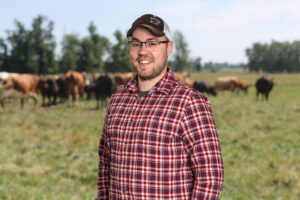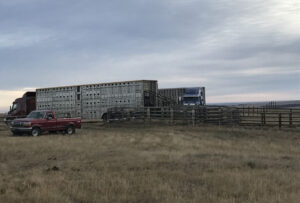Until the Cows Come Home: Five Strategies to Stop Sickness Before It Starts This Fall

Biosecurity hazards on beef operations are sometimes overlooked, however the risk of introducing disease onto your farm is real and relatively common. It can be especially prevalent in the fall when cattle return from various community pastures, grazing leases or even pastures that border neighbouring livestock.
Other common fall practices such as borrowing stock trailers or outsourcing transport, sharing chutes or buying in replacement breeding stock can bring more risk than what producers bargain for. Fortunately, there are some practices that producers can implement to help manage their biosecurity risks.

Producers first have to accept and be aware of biosecurity risks that exist. “No animal industry can claim to be a closed industry,” explains Dr. Blake Balog.
Balog, who practices veterinary medicine out of the Bow Valley Veterinary Clinic at Brooks, Alberta, says visiting farms and auction marts, hosting tours, attending livestock and 4-H shows, borrowing livestock equipment and even visiting your vet clinic can be risky endeavours.
Consider outsourced feeds when thinking about disease exposure. “Anthrax has been brought in from baled up feed or silage,” Balog says, adding that feeds can also contain mycotoxins or ergot and cause problems. “These too have to be part of your biosecurity radar,” he says.
Daniel Pecoskie, DVM with Metzger Veterinary Services out of Linwood, Ontario, says bringing replacement stock on-farm is a common risk producers must address. “I think a lot of times replacement cattle coming in get overlooked, or on the side of the bull, the potential to bring in disease with new arrivals,” Pecoskie explains.

A great place to start developing a biosecurity plan is with your veterinarian. Though an established veterinary-client-patient relationship, you can work to identify risks and mitigate hazards. Having a comprehensive on-farm vaccination protocol is essential to mitigating any potential viruses, diseases and pest problems that a herd is exposed to.
In addition to effective herd vaccination, there are a few specific practices producers implement:
1. Manage cattle that go into (and come out of) a community pasture strategically.
Balog says producers should take a proactive stance in community grazing situations. “Be a leader in preventative measures,” he says. “Don’t send those troubled critters so you aren’t the person helping spread,” Balog adds. For example, animals in poor body condition score should not be shipped to a community pasture.

“Tagging and managing as separate cohorts can be a good management tool,” says Balog, both before and after the grazing season. After cattle return, ideally, they will be kept separate from the main herd until preg-checking. “It really depends what bug we are talking about, but often we are going to see something within a three-to-four-week time frame,” he says. If producers do end up bringing home cows carrying a disease that causes fetal loss such as BVD or IRB, having them apart from the main herd limits that spread. “That three-to-four-week window pays dividends in terms of disease prevention.”
Balog suggests pasture staff should have a standardized protocol for vaccination, disease identification and treatment. And, they should work closely with a veterinarian when things aren’t looking right.
Pecoskie adds that community pastures and commingled grazing require everyone to get on board. “It takes a concerted effort on behalf of all parties involved to come up with a protocol to reduce the risk of mixed cattle exposed to other disease,” he explains.
2. Isolate new arrivals and test target animals.
“Quarantine new arrivals in a separate pen or field or paddock for three weeks,” recommends Pecoskie, in order to monitor for signs of transmissible diseases and things like visible dermatitis, lameness and ringworm. Isolated new entrants should not have access to common watering points or nose-to-nose contact with other cattle from the main herd.
When purchasing breeding stock, ask about vaccination status and any historical health issues such as foot rot, pink eye, pneumonia or scours, that the sellers may have had. “Sometimes animals may appear healthy but there are some pathogens that carry over in mucosa and flare up in the year later on,” says Balog.
Pecoskie says buyers or sellers should consider testing cattle prior to any transactions. “BVD, IBR, reproductive diseases like leptospirosis, Johne’s disease, those are some of the diseases that we can scan for,” explains Dr. Pecoskie.
Dr. Balog agrees there are cost-effective testing options for many transmissible diseases, particularly BVD. He adds that producers can request a fecal panel test for internal parasites (depending on the time of year) and also suggests testing bulls for trichomoniasis and vibrio.
Testing can also be used as a marketing tool. “Doing and showing the steps we are taking – maybe it’s routine disease testing – that can get us to another level of disease-free status and marketing opportunities,” Balog adds.
Biocontainment refers to managing the spread of disease within a farm.
Balog says producers should also have a biocontainment plan to isolate sick cattle from within their existing herd. “A lot of the bugs that we think about, things like pneumonia and scours, are already there on your operation, how do you reduce that exposure?” he asks. For example, Balog says producers should avoid bringing home a sick cow and putting her in with replacement heifers. “Now you’re exposing the sick animal to your naïve animals,” he says. “Create true biocontainment and have a sick pen and keep them away from other animals.”
3. Keep it clean.
Cleaning and disinfecting commonly used fall equipment such as portable scales, chutes or transport trailers between farms is key.

Pecoskie says using farm-specific clothing and ensuring boots are cleaned and disinfected between subsequent farms can also go a long way to preventing the spread of disease. “For other equipment like bottles and tubes, wash with soap and warm water,” he says. “Change needles frequently, clean syringes and make sure they are nice and dry between uses,” he adds, so that subsequent usage for vaccination or treatment is safe and effective.
“Even sharing equipment within operations on different critters is a risk,” warns Dr. Balog. For example, administering oral meloxicam to a scouring calf, then using the same contaminated tube on calves in a branding pen can result in the spread of disease.
“With things like drenchers, tubes, bottles, you want to work clean to dirty, from the lowest risk to highest risk animals,” Balog explains. “Have a separate tube for scouring calves and a separate one for newborns.”
4. Take care if you share.
Pecoskie says it’s best if producers avoid sharing items between farms, however if it is going to happen, it should be well thought out. “There should be a conversation between producers about vaccine protocols in one herd versus the other,” he advises. “Discuss the level of risk and protection between farms sharing equipment like chutes, or animals such as bulls,” he says.
Good communication can help reduce risks. “If a problem arises, you at least have an idea of what you are dealing with as far as vaccine status and parasite status and what you may be exposing your herd to,” Pecoskie adds.
5. Know the flow.
On a broader scale, it’s valuable to assess the animal flow on your farm. “How is your operation laid out? What kind of interactions do you have that might be risky? Where does deadstock go? Where are your pastures and do they border someone with a lower biosecurity?” questions Balog.
Balog suggests taking a Google map of your farm facility to look at drainage, assess potential risks, and consider making changes for pens for different groups or age categories of animals to reduce exposure to effluent or other disease reservoirs. “Look at animal movement through calving season and throughout the year.”
Pecoskie says that getting back to the basics of making sure yards are clean and producers have adequate bedding will help manage disease during high-risk times such as calving or bringing new animals in.
Biosecurity on Every Scale
Whether you have a small-sized farm or a larger operation, biosecurity matters. “The risk of bringing something onto your farm or transmitting a disease to another farm can financially have an impact, as well as a welfare impact,” says Dr. Pecoskie.
Effective biosecurity also has a global influence. “The threat of foreign animal diseases can have an impact on our beef herds and beef industry and impact trade,” Balog says. Canada’s stringent animal health, food safety and biosecurity standards can instill confidence in our beef sector throughout the value chain.
There is also a human health benefit to practicing biosecurity measures when it comes to the issue of zoonotic diseases, which are transmissible from animals to people. “Zoonotic diseases are real and exist on our operations, some are scarier than others and some we don’t know if there is a link,” Dr. Balog says.
Balog says reducing biosecurity risks and planning ahead can take just a few extra minutes each day, and often doesn’t have to cost a lot. “It comes down to a few simple things done right every day.”
Learn More
- Think You Have a Closed Herd? (BCRC interactive graphic)
- Think You Have a Closed Herd? Think Again. (BCRC post)
- Always Look a Gift Cow in the Mouth (BCRC post)
- Biosecurity During Calving (VBP+ webinar)
Le partage ou la réimpression des articles du blog du BCRC est bienvenu et et encouragé. Veuillez mentionner le Conseil de recherche sur les bovins de boucherie, indiquer l’adresse du site web, www.BeefResearch.ca/fr, et nous faire savoir que vous avez choisi de partager l’article en nous envoyant un courriel à l’adresse info@beefresearch.ca.
Vos questions, commentaires et suggestions sont les bienvenus. Contactez-nous directement ou suscitez une discussion publique en publiant vos réflexions ci-dessous.